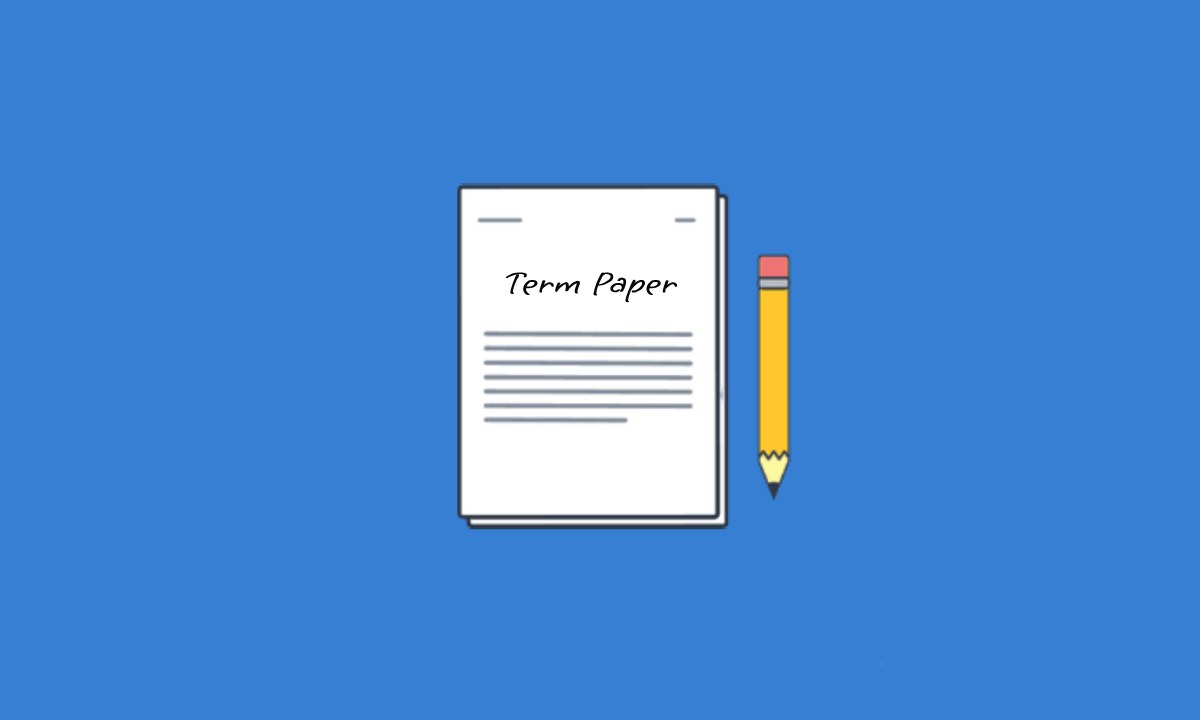What is Term Paper?
A term paper is a research paper written by students over an academic term, accounting for a significant portion of a grade. It’s usually due at the end of a semester or term. Term papers typically involve a deep dive into a particular topic or subject area, requiring students to conduct extensive research, analyze information, and present their findings in a structured format.
Term Paper Parts:
Term Paper Consist of the Following Parts:
Title Page:
This includes the title of the paper, the author’s name, the course name, the instructor’s name, and the date of submission. It sets the basic information about the paper.
Abstract (optional):
In some cases, particularly for longer papers or those submitted to academic journals, an abstract may be included. It provides a brief summary of the paper’s main points, findings, and conclusions.
Introduction:
This section introduces the topic of the paper, provides background information, and outlines the purpose and scope of the research. It often includes a thesis statement or research question that the paper will address.
Literature Review:
This part summarizes and analyzes existing research and literature relevant to the topic. It demonstrates the student’s understanding of the existing scholarship and provides context for their own research.
Methodology (if applicable):
If the paper involves original research, this section outlines the methods used to collect and analyze data. It should explain the research design, sampling techniques, data collection procedures, and any tools or instruments used.
Findings/Results:
This section presents the findings of the research. It may include tables, graphs, or other visual aids to help illustrate the results. The findings should be presented in a clear and organized manner.
Discussion:
Here, the findings are interpreted and analyzed in relation to the research question or thesis. This section may also compare the results to existing literature and discuss their implications.
Conclusion:
The conclusion summarizes the main findings of the paper, restates the thesis or research question, and discusses the broader implications of the research. It should also suggest areas for future research or exploration.
References/Bibliography:
This section lists all the sources cited in the paper, following a specific citation style (e.g., APA, MLA, Chicago). It provides readers with the information they need to locate the sources themselves.
Appendices (if applicable):
Supplementary materials such as raw data, questionnaires, or additional tables and figures may be included in appendices to provide further detail or support for the research.
Term Paper Format:
The format of a term paper generally follows the guidelines provided by the instructor or the academic institution. However, here’s a typical format that is commonly used:
Page Setup:
- Use a standard letter-sized (8.5″ x 11″) paper.
- Set margins to 1 inch on all sides.
- Use a readable font such as Times New Roman or Arial, size 12.
- Double-space the entire paper, including the title page, abstract (if included), body paragraphs, references, and appendices.
- Number all pages consecutively in the upper right corner, starting with the title page.
Title Page:
- Center the title of the paper at the top of the page.
- Include the author’s name, course name/number, instructor’s name, and date below the title, each on a separate line and centered.
Abstract (if required):
- Begin on a new page after the title page.
- Provide a concise summary of the paper’s main points, findings, and conclusions. It should typically be around 150-250 words.
- Avoid including citations or references in the abstract.
Main Body:
- Begin with the introduction section, which introduces the topic, provides background information, and presents the thesis statement or research question.
- Organize the body of the paper into sections or subsections based on the topics being discussed.
- Use clear and logical transitions between sections to guide the reader through the paper.
- Support arguments and findings with evidence from scholarly sources, properly cited.
- Use headings and subheadings to help organize the content and improve readability.
Conclusion:
- Summarize the main findings of the paper.
- Restate the thesis or research question and its significance.
- Discuss the broader implications of the research and suggest areas for further study or exploration.
References/Bibliography:
- Begin on a new page after the conclusion.
- List all sources cited in the paper in alphabetical order by the author’s last name.
- Follow a specific citation style (e.g., APA, MLA, Chicago) as required by the instructor or institution.
Appendices (if included):
- Begin on a new page after the references.
- Include any supplementary materials such as raw data, questionnaires, or additional tables and figures.
Formatting Details:
- Use consistent formatting throughout the paper, including headings, font style, and citation style.
- Use italics for titles of books, journals, and other longer works.
- Use quotation marks for titles of articles, chapters, and shorter works.
- Include page numbers for direct quotations.
- Proofread the paper carefully for grammar, spelling, and punctuation errors.
How to Write Term Paper?
Writing a term paper involves several key steps, from selecting a topic to revising and editing your final draft. Here’s a general guide on how to write a term paper:
Choose a Topic:
Select a topic that interests you and is relevant to your course or assignment guidelines. Consider the scope of the topic and its potential for research.
Conduct Research:
Gather relevant sources such as books, scholarly articles, and reputable websites to inform your paper. Take notes and organize your research materials.
Develop a Thesis Statement:
Formulate a clear and concise thesis statement that states the main argument or purpose of your paper. Your thesis should be debatable and guide the direction of your research.
Outline Your Paper:
Create an outline that outlines the structure and main points of your paper. Include sections for the introduction, literature review, methodology (if applicable), findings/results, discussion, conclusion, and references.
Write the Introduction:
- Begin with a compelling introduction that introduces the topic and provides background information.
- Present your thesis statement or research question.
- Outline the scope and purpose of your paper.
Write the Body:
- Organize your paper into sections or subsections based on the outline.
- Present your arguments, findings, and analysis in a logical and coherent manner.
- Use evidence from your research to support your points, and properly cite your sources.
Write the Conclusion:
- Summarize the main findings and arguments of your paper.
- Restate your thesis statement and discuss its significance.
- Consider the broader implications of your research and suggest areas for further study.
Revise and Edit:
- Review your paper for clarity, coherence, and organization.
- Check for grammar, spelling, and punctuation errors.
- Ensure that your paper follows the formatting guidelines required by your instructor or institution.
- Consider seeking feedback from peers, tutors, or instructors to improve your paper.
Finalize Your Paper:
- Make any necessary revisions based on feedback.
- Proofread your paper one final time to ensure it is polished and error-free.
- Format your paper according to the required style guide (e.g., APA, MLA, Chicago).
- Include a title page, abstract (if required), references, and any appendices.
Submit Your Paper:
- Submit your completed term paper by the deadline specified by your instructor or institution.
- Keep a copy of your paper for your records.
By following these steps, you can effectively plan, research, and write a well-organized and coherent term paper. Remember to start early to allow yourself enough time for each stage of the writing process and to produce your best work.
Term Paper Topics:
Choosing a term paper topic can be both exciting and challenging. Here’s a list of diverse topics across different disciplines that you might consider for your term paper:
English Literature:
- The portrayal of mental illness in literature: A comparative analysis of characters in classic and contemporary novels.
- The use of symbolism in Shakespeare’s works: Analyzing the significance of recurring motifs in selected plays.
- Postcolonial literature and identity: Exploring themes of cultural hybridity and resistance in the works of authors from former colonies.
- Feminist perspectives in literature: Examining the representation of women and gender dynamics in modern literature.
- The role of nature in Romantic poetry: Comparing the treatment of nature in the works of Wordsworth, Coleridge, and Keats.
Computer Science:
- Machine learning algorithms for image recognition: A comparative study of convolutional neural networks and support vector machines.
- Cybersecurity threats and mitigation strategies in cloud computing environments.
- The impact of quantum computing on cryptography: Challenges and opportunities.
- Ethical considerations in artificial intelligence: Addressing bias, fairness, and transparency in algorithmic decision-making.
- Blockchain technology and its applications beyond cryptocurrency: A review of current trends and future prospects.
Management:
- Leadership styles and their impact on employee motivation and productivity.
- Sustainable business practices: Analyzing the implementation of corporate social responsibility initiatives in multinational corporations.
- Organizational culture and its role in shaping employee behavior and performance.
- Change management strategies: Case studies of successful and unsuccessful organizational change efforts.
- Strategic human resource management: Aligning HR practices with organizational goals and objectives.
Economics:
- Income inequality and its implications for economic growth and social stability.
- The economics of climate change: Assessing the costs and benefits of mitigation and adaptation strategies.
- Behavioral economics and decision-making: Examining deviations from rational choice theory in consumer behavior.
- The role of central banks in monetary policy: Case studies of recent monetary policy decisions and their effects on the economy.
- International trade and globalization: Analyzing trade agreements and their impact on domestic industries and employment.
Sociology:
- Social media and its influence on interpersonal relationships and social behavior.
- Urbanization and its effects on community cohesion and social inequality.
- Identity politics and social movements: Exploring the intersectionality of race, gender, and sexuality in contemporary activism.
- The sociology of education: Examining the role of schools in reproducing or challenging social inequalities.
- Health disparities and access to healthcare: Investigating the social determinants of health and disparities in healthcare outcomes.
Political Science:
- Populism and its impact on democratic institutions and norms.
- Electoral systems and political representation: A comparative analysis of proportional representation and first-past-the-post systems.
- International relations theory: Assessing the relevance of realism, liberalism, and constructivism in understanding contemporary global politics.
- Political polarization and its effects on governance and policymaking.
- Human rights and humanitarian intervention: Ethical dilemmas and challenges in international politics.
Finance:
- Financial markets and economic development: Exploring the role of capital markets in fostering economic growth.
- Behavioral finance: An analysis of investor behavior and its implications for market efficiency.
- Corporate finance and capital structure decisions: Case studies of firms’ financing choices and their impact on firm value.
- Risk management in financial institutions: Assessing strategies for managing credit, market, and operational risks.
- Financial regulation and regulatory reform: Evaluating the effectiveness of regulatory measures in maintaining financial stability and protecting investors.
Microeconomics:
- Market structure and competition: Analyzing the effects of monopolies, oligopolies, and perfect competition on consumer welfare and efficiency.
- Consumer choice and utility maximization: Exploring consumer preferences and demand theory.
- Labor market dynamics: Examining wage determination, labor supply and demand, and the impact of minimum wage policies.
- Price discrimination and its effects on market efficiency and consumer surplus.
- Game theory and strategic decision-making: Applications in business strategy, negotiation, and auction design.
Electrical Engineering:
- Renewable energy technologies: Assessing the feasibility and scalability of solar, wind, and hydroelectric power generation.
- Internet of Things (IoT) applications in smart cities: Analyzing the role of sensor networks and data analytics in urban infrastructure.
- Power system stability and reliability: Modeling and simulation of transient stability and voltage regulation in electrical grids.
- Electric vehicles and sustainable transportation: Challenges and opportunities in battery technology, charging infrastructure, and grid integration.
- Signal processing techniques for biomedical applications: Image processing, data analysis, and machine learning in medical imaging and diagnostics.
These topics cover a wide range of subjects within each discipline, providing a starting point for further research and exploration.
Term Paper Vs Research Paper:
Term papers and research papers are both academic assignments that involve conducting research and presenting findings, but they differ in several key aspects:
Purpose:
Term Paper: The primary purpose of a term paper is to demonstrate understanding of the material covered in a particular course or semester. It typically focuses on synthesizing course content, applying concepts, and demonstrating critical thinking skills.
Research Paper: The primary purpose of a research paper is to contribute new knowledge or insights to a particular field of study. It involves original research, analysis, and interpretation of data to address a specific research question or problem.
Scope:
Term Paper: Term papers often cover a broad topic or theme related to the course content. They may require literature reviews, analysis of existing theories, and application of course concepts to real-world examples.
Research Paper: Research papers typically have a narrower focus and require in-depth exploration of a specific research question or hypothesis. They involve original research methods, data collection, and analysis to address the research problem.
Length:
Term Paper: Term papers vary in length depending on the instructor’s requirements and the level of the course. They are usually shorter than research papers, ranging from a few pages to around 10-20 pages in length.
Research Paper: Research papers tend to be longer and more comprehensive than term papers. They often range from 15-30 pages or more, depending on the depth of research and complexity of the topic.
Originality:
Term Paper: While term papers may require critical analysis and synthesis of existing literature, they typically do not involve original research or the generation of new data.
Research Paper: Research papers require originality and novelty. They involve conducting new research, collecting and analyzing data, and drawing original conclusions based on the findings.
Audience:
Term Paper: Term papers are typically written for an audience of classmates and instructors who are familiar with the course material. They may focus on explaining and applying course concepts rather than introducing new ideas.
Research Paper: Research papers are often written for a broader audience within the academic community. They are expected to contribute to the existing body of knowledge in a particular field and may be published in academic journals or presented at conferences.
Overall, while both term papers and research papers involve research and writing, they serve different purposes and have distinct requirements in terms of scope, length, originality, and audience.



